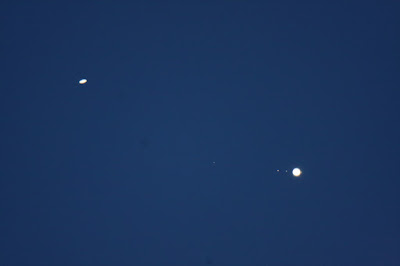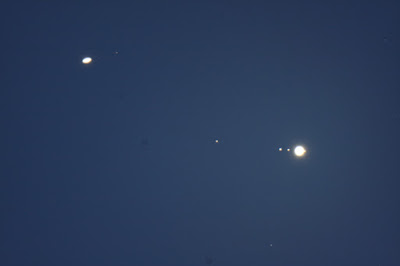This time I went out to participate in the RASC Toronto Centre live stream YouTube event. Another ad-hoc event coordinated by Andrew.
3:59 PM. Sun was nearly down. Moon was obvious but behind the trees for me. Very clear skies!
Electrical hooked up. Vixen installed with last night's polar alignment. Again with three counter-weights. Eyepiece case. Kit bag with camera and specs. Various cables. Grabbed Rhonda's old chair in addition to the astro-chair.
Didn't know where my compass was. Not that I needed it tonight...
Grabbed the chilled OTA, with finder in place. Unwrapped the baader eyepiece, still in the WO mirror diagonal, and installed it in the WO focuser. Dusted off the dropped cap. Powered the mount. Skipped a star alignment. Slewed to the Moon and turned on tracking.
The bunnies were watching me.
4:04. Headed inside for the netbook, power supply, winter coat, and phone.
Installed the camera and its external power supply. Connected John Repeat Dance to the DSLR. Powered the netbook. Ran two jumpered 50-foot ethernet lines and plugged into the hardline. Fired up the Canon EOS Utility. And it froze. Restarted Windoze.
My office. Motorola, Android, f/2, 1/30 second, ISO 66, HDR. Before the additional laptop was brought out and set up...
4:23. The netbook acted better. EU started correctly. Focused on the Moon, first moving the primary, then using the external. Started Zoom on the phone. Checked Evernote for the shared screen link.
Tried to run OBS Ninja but it didn't work. Tried to install Brave 32-bit. Didn't work. Kricky. Plan B, I thought.
Fetched the laptop, its power brick, the Canon software CD, and a USB cable to keep the phone alive. Started installing the EOS software to the laptop.
4:39. I was admitted to the Zoom session on the Android. Andrew and Rick were up and running. In fact, Rick was already on the planets. Rick could see the shadow of Io on the Jupiter! I could not see the two gas giants visually yet.
Activated the Ninja link on the laptop as the Canon installer continued. It wanted a reboot. Uh boy.
[ed: Missed the message at the time. 4:43. Phil C pinged me. The Great Red Spot was to transit at 5:30 PM.]
Realised I could use the netbook as the information console. Launched SkyTools to get the distance of the Moon to the planets. Slightly down from the Moon and 20° to the right. One Hang Loose away. Still couldn't see the planets...
4:56. Finally started EOS Utility. I had a working setup! Turned on live view. Nothing in the field. Must have drifted off from the Moon. Slewed. Andrew could see it. He readied to start the live event on the RASC TC YouTube.
I checked the camera. Oh. I was in C3; switched to C1. That explains why I've been getting the weird message about live view being disabled... Worked the focus.
Checked for the planets. Got 'em! Clear sight line for the telescope rig. w00t! Slewed by RA—there they were. Centred in the finder. Two minutes to go-live. Saw a planet on the sensor. Slewed at slow speed. Holy Universe! A great view.
Touched up the focus. I rotated the camera a bit.
Andrew started the 'cast. Introduced everyone. He shared the views of his, Rick's, and my camera. I did some commentary.
Clarified that on the 21st they will be 6 arc-minutes apart but discernible to the eye as two points.
Claudio started joining in.
I shot some photos along the way. Common telescope-camera details. C8, f/10, external focuser, manually focused, tracking, not star aligned, Canon 40D, daylight WB, RAW. For all, north is up, east is left.
5:19. ISO 1600, 1/4 second. About 20 arc-minutes apart. Yes! All four moons for Jupiter. Left to right: Callisto, Ganymede, Europa, and Io. Titan is just barely visible, 2:30 o'clock position.
Wow.
Shared the distances. Jupiter around 880 million kilometres from the Earth while Saturn was 1.6 billion. So about 700 million km apart in space.
Answered some questions relayed from the YouTube chat.
5:23. ISO 800, 1/60 second. Wanted a quick exposure to not blow out the planets.
We talked about the elevation or altitude above the horizon. 14 degrees at the moment. We talked about seeing conditions. I thought it was good seeing. A bit better than last night.
Talked about how the EOS software worked. And that the 40D is not modified.
So amazing.
5:37. ISO 800, 10 seconds. Did a long shot to coax out for Saturnian moons. Dione and Rhea are roughly inline with Titan, on same side. Dione is the closer of the two. Tethys is visible to the left of Saturn, just off the rings, half the distance of Dione, about the 8 o'clock position. I think Iapetus is out of frame... The bright star below Jupiter is HD 190821.
5:43. Subsequent photos showed diffraction from the tree branches. I was done.
Rick showed the Moon for a bit. I some a glow around the Moon from thin upper cloud.
6-ish. We wrapped the live broadcast.
Viewers from Calgary and the US and A. Some local RASC peeps. Cool!
I thanked the team. And Betty. Stopped the Zoom.
I was cold.
Rhonda arrived home. She had seen the planets while driving.
Did a very fast teardown.
6:05. Removed the Vixen Super Polaris and headed indoors. The mount and GoToStar worked great. Amazingly well for a rough polar alignment and a zero-star alignment. Ha!
A good run. We've been very fortunate with this weather. The prospects for Monday 21 December are not lookin' good though...
6:30. Oh! Remembered my portable weather station this time. Precip tomorrow, air pressure steady, 45% relative humidity, -5.5°C air temperature.
Raw video recording of the live stream is available for viewing.
§
Andrew talked about his doubler. I just checked SkyTools. I'm in "the doubler zone" starting tomorrow night...!
§
I must dub the Windows 10 laptop. You shall be known as John Gomez.






No comments:
Post a Comment